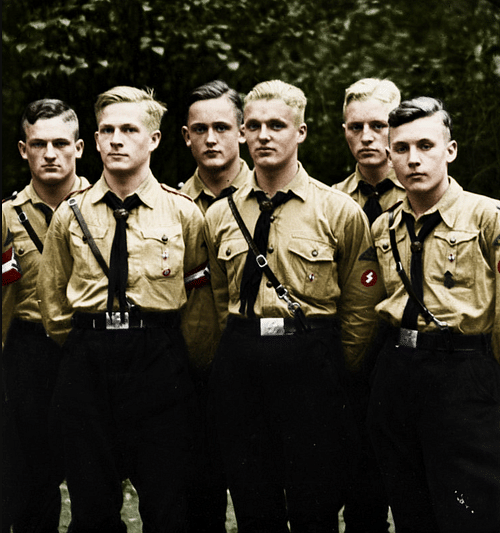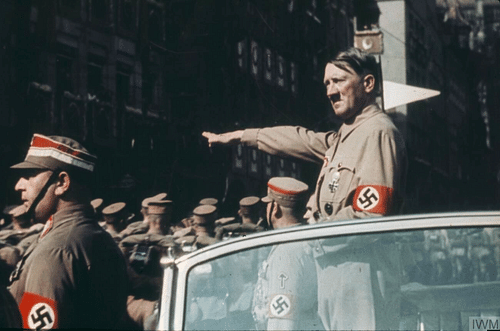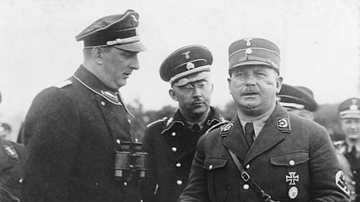
The Hitler Youth (Hitlerjugend or HJ), named after the leader of the German Nazi Party Adolf Hitler (1889-1945), was designed to indoctrinate 14-18 year-old boys into the party's way of thinking. Its activities promoted physical exercise, team-building, and Nazi ideology. During the Second World War (1939-45), HJ members operated anti-aircraft guns and fought in the defence of Berlin.
The Structure of Nazi Youth Organisations
The Hitler Youth was founded in 1926 and drew on what was already a strong tradition of various types of youth movements in Germany. The organisation was originally aimed at young males between the age of 14 and 18, however, the idea was expanded in 1929 to include girls of the same age, who were invited to join the League of German Maidens (Bund Deutscher Mädel or BDM). In 1931, the organisation was further expanded to appeal to an even younger age group. For boys, there was the German Young People (Deutsches Jungvolk), and for girls, the Young Maidens (Jungmädelbund). Members of both of these groups were between the age of 10 and 14, and the purpose was to improve fitness, and, for the girls, to "develop the domestic skills required of a future wife and mother" (McDonough, 70). For boys aged 6 to 10, there was the Pimpfen (Cubs), a preparatory group for the Hitler Youth proper. At the other end of the scale, when members had reached the age limit of 18, males joined the State Labour Service or the German Army, and females joined the community-promoting Faith and Beauty Society (Glaube und Schönheit). When ready for the working world, certain professions such as teaching were only open to those who had served in the Nazi youth organisations.
The Hitler Youth was made an official state organisation in 1933. In 1936, the state decided that the Hitler Youth was the only permissible organisation for boys, and all rival groups were prohibited. The Hitler Youth was always closely tied to the SS (Schutzstaffel), the elite Nazi paramilitary group. Indeed, males who had gone through the German Young People, the Hitler Youth, and then served six months in the State Labour Service, very often joined the SS. This system was applied in Nazi-occupied territories during WWII. From April 1940, membership of the Hitler Youth organisations was made compulsory for all boys between the age of 10 and 18.
Membership
To gain entry into the Nazi elite later in life, membership of the Hitler Youth was often considered a necessary prerequisite. The majority of members came from the middle class, but anyone could join, that is until 1935 when children had to bring a signed form from their parents declaring they had no Jewish ancestry (Jews being defined by the Nuremberg Laws of 1935). Hitler, ever the idealist, stated that members should be "slim and slender, swift as greyhounds, tough as leather, and hard as Krupp steel" (Dear, 425). Above all, Hitler wanted loyalty, and so each HJ member had to swear the following oath upon joining:
In the presence of this blood banner, which represents our Fuehrer, I swear to devote all my energies and my strength to the saviour of our country, Adolf Hitler. I am willing and ready to give up my life for him, so help me God.
(Shirer, 253)
By 1933, the Hitler Youth boasted 2.3 million members, but by 1938, this figure had rocketed to 7.7 million. The Hitler Youth was popular, but not everyone wanted to join, of course. Parent-, peer- and party-pressure, and the compulsion to join from 1940, meant that many boys were members against their will. Victor Klemperer (1881-1960), the celebrated Jewish diarist, recorded the following comments made to him by one Hitler Youth member:
We are all in the HJ; most of us would dearly like not to be in it…They are 60, 80, 100 percent against the Nazis, only the three stupidest boys, whom no one respects, are entirely for it.
(58)
Hitler Youth members wore a uniform consisting of a brown shirt (like the Nazi paramilitary group the Sturmabteilung or SA), black shorts, a black leather belt with a knife, and a black scarf tied around the neck. Members wore the Hitler Youth armband, which had red, white and red horizontal stripes with a black swastika.
The leader of the Hitler Youth from 1931 to 1940 was Baldur von Schirach (1907-1974), who was also the Youth Leader of the German Reich. Von Schirach, who reported directly to Hitler, became, in effect, "the dictator of youth in the Third Reich" (Shirer, 253). In August 1940, Artur Axmann (1913-1996) took over as the new leader when von Schirach became Gauleiter (regional leader) of Vienna, Axmann having served as von Schirach's deputy.
Purpose & Activities
The creation of the Hitler Youth and other similar organisations allowed the ruling Nazi party to indoctrinate the youth of Germany and other states within the Third Reich with Nazi ideology. This way, Hitler was convinced his new Reich would last for a thousand years. Ideas instilled into Hitler Youth members included:
- the importance of physical fitness
- obedience to authority
- the importance of family, comradeship, and loyalty
- the adoration of Adolf Hitler
- nationalism and patriotism
- a love of militarism
- the belief that non-Germanic or non-Aryan peoples are inferior and even dangerous and so should be removed from society, particularly the often loosely defined groups of Jews, Communists, Romani, and people with disabilities
As Hitler explained in a speech in 1938, the wider purpose of the Nazi youth organizations was as follows:
There will be a new German youth, and we shall train them from a very early age for this new state…These young people will learn nothing but to think German and act German. And when these boys and girls join our organizations at the age of 10 and for the first time in their lives get a breath of fresh air there and feel, then 4 years later they'll come to the Hitler Youth. And there we'll keep them another 4 years. And then we certainly won't put them back in the hands of those who trained people to be members of our old classes and social groups. Instead, we'll take them right into the party and into the Labour Front, into the SA or the SS, into the National Socialist Motor Vehicle Driver Corps, etc…And they will never be free their whole life long.
(Dülffer, 114)
Hitler elaborated on the purpose of the Hitler Youth and the Nazi education system in general in 1939:
…my magnificent youngsters! Are there finer ones in the world? With them I can make a new world. My teaching is hard. Weakness has to be knocked out of them…A violently active, dominating, intrepid, brutal youth – that is what I am after…It must be indifferent to pain. There must be no weakness or tenderness in it…I will have no intellectual training. Knowledge is ruin to my young men…
(Hite, 276)
The first years in the HJ were spent in group physical exercises. Summer camps were run where exercise, physical fitness, and team-building were emphasised. HJ members stayed in camps at the annual Nuremberg rally, the Nazi party convention. Military training was part of the Hitler Youth's education programme, and, from age 12, a boy was instructed how to use weapons like rifles and machine guns. A taste of army life was given at age 14 when boys spent one month in an army camp.

The Hitler Youth was involved in collecting money for state-sponsored charity drives such as helping the poor in wintertime. The other face of the organisation can be seen in police reports which show that Hitler Youth members were involved in attacks on those identified as Jews. An eyewitness to one such attack, Bella Fromm, noted in her diary:
We were about to enter a tiny jewelry shop when a gang of ten youngsters in Hitler Youth uniforms smashed the shop window and stormed into the shop, brandishing butcher knives and yelling, 'To hell with the Jewish rabble!'
(Friedländer, 262)
As in many other Nazi organizations, behind the façade of togetherness, there were troubles in the Hitler Youth. The organisation was plagued with corruption and fear. Klemperer noted another conversation with a former Hitler Youth leader:
I asked him what repelled him. 'The leaders – fellow pupils – take more money from us for excursions than they spend. It is impossible to check, a couple of marks always go into their pockets. I know how it's done, I've been a leader myself…One fellow who was really poor, a leader for some time, is now riding a motorcycle'…'Don't the others notice too' – 'They're so stupid,' and then: 'No one dares say anything or talk to the others. Everyone is afraid of everyone else'.
(88)
Rival Groups
In a totalitarian regime, it was difficult to protest against the obligations the state imposed. Some youths did refuse to join the Hitler Youth, and there were rival organisations, notably the Edelweiss Pirates (Edelweisspiraten), so called because they wore an edelweiss (an alpine flower) badge on their lapel. Members of the Pirates were typically 14- to 18-year-olds, working class, and living in the inner cities. Some girls were members of the group, but they were a minority. The Pirates often attacked patrols of Hitler Youth, but punishments could be severe, including the death penalty.
Another group, the Swing Youth (Swing-Jugend), were more benign members of the middle class, who simply wanted to enjoy the things the Nazis would not permit them to do openly such as listen to jazz and foreign music, wear foreign clothes, and speak English. There were only a few thousand members of the Edelweiss Pirates and the Swing Youth, but they at least showed that there were, albeit very limited, opportunities for young people to demonstrate their wish not to conform to the Nazi norms.
There were, too, some parents who objected to their children joining the Hitler Youth, not always on ideological grounds but because the pregnancy rates amongst members of the Nazi youth organizations – all those nights under canvas in the wilds of Germany – were scandalously high. Whatever a parent's hesitation, though, and as with many other instances of life under the Nazis, non-conformity risked severe punishments. Parents who refused to send their children to the youth organisations could receive a fine and even a prison sentence.
Military Service
In 1943, when the drain on Germany's resources became critical during the war, Hitler Youth members in their final year were enrolled in the army directly. The Hitlerjugend Division was part of the Waffen-SS (the military arm of the SS). Hitler Youth members were invariably fiercely loyal to the Nazi regime, even when the course of the war took a serious turn against Germany and ultimate defeat stared its members squarely in the face. The Hitler Youth served other useful functions in the defence of the state, such as working in the Patrol Service (Streifendienst), a junior police service. From 1943, Hitler Youth members aged between 15 and 17 were used extensively in operating anti-aircraft guns during the Allied bombing of Germany.
From 1944, the Hitler Youth was also deployed in cities as part of the civil defence force, the Deutscher Volkssturm, which dealt with bomb damage and fires, and conducted patrols. In the final days of the Reich, Hitler Youth members were tasked with digging defences like tank traps and, in Berlin, fighting the enemy directly. Willy Feldheim gave the following account of his experience in the Hitler Youth:
I was a member of the Hitler Youth and in 1945 I was fifteen years old. As the Russians came through Poland to the border I felt I had to do something because the Russians are coming and this is my homeland. And so I went back to the military training camp and there, after maybe two weeks, came a commission of Army and SS and asked for Hitler Youths to form a special force anti-tank brigade and we would shoot tanks with a kind of bazooka, a small one…we came in the Berlin area. It was early in the morning and we had to hold this area of very small gardens and wooden houses, we had to defend this line…and I hear a very big noise and four Russian tanks were coming with Russian infantry on top. I saw some of our young boys, they jumped out of their holes and they were shooting to the tanks and destroyed one of the tanks, and others were shooting with their guns and killed all the Russian soldiers. And the Russians must have been in a sweet factory because they had all their arms full of sweets and chocolates. They were falling on the street and all the little boys – because everybody in our unit was fifteen or sixteen – they were running on to the street for the chocolate and the sweets.
(Holmes, 291)
Willy survived, but he was one of the lucky few. With their very limited military training, the survival rate of the Hitler Youth in combat in Berlin was only around 10% of the 5,000 youths involved. When Adolf Hitler committed suicide in April 1945, so the Hitler Youth died with him.










